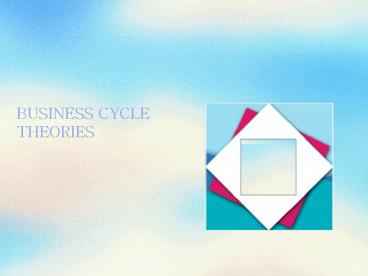Choice, Change, Challenge, and Opportunity - PowerPoint PPT Presentation
1 / 14
Title:
Choice, Change, Challenge, and Opportunity
Description:
The monetarist theory of the business cycle regards fluctuations in the interest ... The new classical theory asserts that only unanticipated changes in aggregate ... – PowerPoint PPT presentation
Number of Views:16
Avg rating:3.0/5.0
Title: Choice, Change, Challenge, and Opportunity
1
BUSINESS CYCLE THEORIES
2
Cycle Patterns, Impulses, and Mechanisms
- Business Cycle Patterns
- The business cycle is an irregular and
nonrepeating up-and-down movement of business
activity that takes place around a generally
rising trend .
3
Cycle Patterns, Impulses, and Mechanisms
- The AS-AD Model
- All business cycle theories can be described in
terms of the AS-AD model. - Business cycle theories can be divided into two
types - Aggregate demand theories
- Real business cycle theory.
4
Aggregate Demand Theories of the Business Cycle
- The two main theories based on aggregate demand
are - Monetarist
- Rational expectations
5
Aggregate Demand Theories of the Business Cycle
- Monetarist Theory
- The monetarist theory of the business cycle
regards fluctuations in the interest rate as the
main source of business cycle fluctuations in
economic activity. - Monetarist Impulse
- The initial impulse is a change in the interest
rate
6
Aggregate Demand Theories of the Business Cycle
- Monetarist Cycle Mechanism
- The mechanism is a change in the interest rate
that shifts the AD curve combined with an upward
sloping SAS curve. - A lower interest rate shifts the AD curve
rightward. - A higher interest rate shifts the AD curve
leftward.
7
Aggregate Demand Theories of the Business Cycle
- A Monetarist business cycle.
8
Aggregate Demand Theories of the Business Cycle
- Money wages are only temporarily sticky, so a
decrease in aggregate demand eventually lowers
money wage rates. - Leftward shifts in the AD curve cause an initial
contraction in real GDP, but money wages fall and
the contraction ends as GDP returns to potential
GDP.
9
Aggregate Demand Theories of the Business Cycle
- The monetarist theory is like a rocking horse, in
that an initial force is required to set it in
motion, but once started the cycle automatically
moves to the next phase.
10
Aggregate Demand Theories of the Business Cycle
- Rational Expectations Theories
- A rational expectation is a forecast based on all
the available relevant information. - The new classical theory of the business cycle
regards unanticipated fluctuations in aggregate
demand as the main source of economic
fluctuations.
11
Aggregate Demand Theories of the Business Cycle
- Rational Expectations Cycle Mechanisms
- This mechanism stresses that changes in aggregate
demand affect the price level and hence the real
wage, which then leads firms to alter their
levels of employment and production. - A recession occurs when a decrease in aggregate
demand lowers the price level and thereby raises
the real wage rate. - This change causes firms to reduce employment so
that unemployment rises.
12
Aggregate Demand Theories of the Business Cycle
- Eventually money wages fall so that the recession
ends. - The new classical theory asserts that only
unanticipated changes in aggregate demand affect
real wages anticipated changes affect the
nominal wage rate and have no effect on real wage
rates. - Anticipated changes in aggregate demand have no
effect on real GDP.
13
Aggregate Demand Theories of the Business Cycle
- Rational Expectations Impulse
- Rational expectations theories regard
unanticipated fluctuations in aggregate demand as
the impulse of the business cycle. - A variant of this theories is called new
Keynesian theory and states that workers are
locked into long-term contracts. Thus anticipated
fluctuations in aggregate demand may create
fluctuations in economic activity.
14
Aggregate Demand Theories of the Business Cycle
- Both theories are like rocking horses, in which
an initial force starts the business cycle but
then the fluctuation automatically proceeds to
the end of the cycle.































